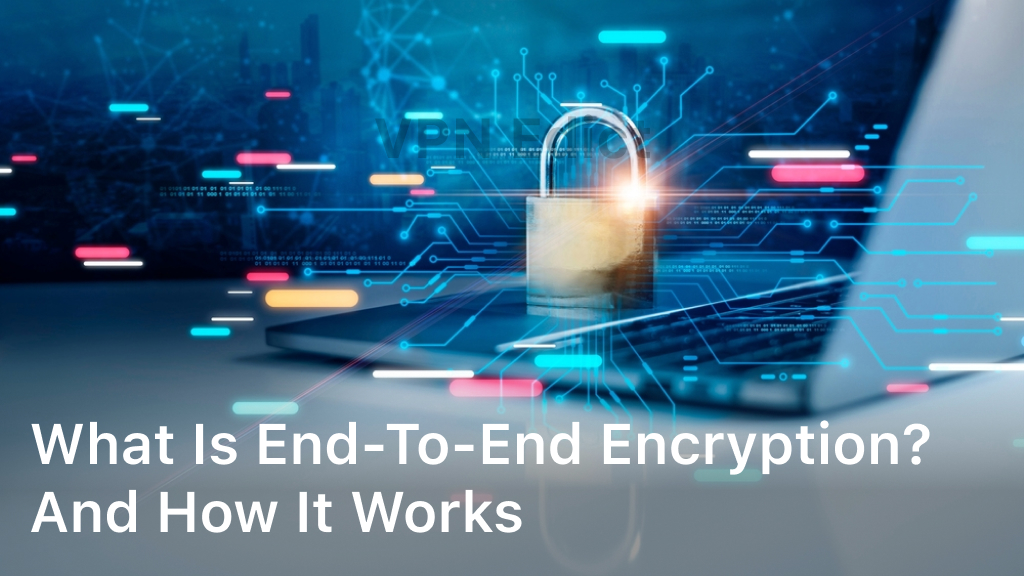What Is End to End Encryption? And How It Works
When it comes to protecting your online privacy, you may have heard the term ‘end-to-end encryption’, but what does it really mean? Simply put, end-to-end encryption is a method of secure communication that ensures only the sender and recipient have access to the content of the message.
Encryption is the process of converting information into a code to protect it from unauthorized access. End-to-end encryption takes this a step further by encrypting the message at the sender’s device and decrypting it at the recipient’s device, bypassing any middlemen or third parties who may try to access the message.
In this section, we will delve into how end-to-end encryption works, and what it means for your privacy and security. Get ready to discover the benefits of using this method of encryption and learn how to protect your online communications.

Understanding Encryption and Its Types
Encryption is the process of converting plain text data into secure, encoded messages. It plays a crucial role in securing communication channels, preventing unauthorized access to sensitive data. Different types of encryption methods are used to safeguard online information. Let’s explore some of the common encryption techniques:
- Symmetric encryption: This method uses the same key for encryption and decryption. Symmetric encryption is suitable for transactions where both parties have access to the same key, such as in secure messaging apps.
- Asymmetric encryption: Asymmetric encryption uses two different keys – one for encryption and another for decryption. This technique is helpful when exchanging information with an individual who does not have access to the same key.
- Hashing: Hashing converts a message of any length into a fixed format, which cannot be reversed. The resulting hash value provides a unique and specific fingerprint for the original message.
Understanding the different types of encryption methods helps in selecting the best encryption process for particular communication and data storage needs.
The Importance of End-to-End Encryption
End-to-end encryption is crucial for maintaining secure and private communication in today’s world of digital messaging. By using end-to-end encryption, only the intended recipient can access the encrypted message. This provides multiple benefits, including:
- Better Privacy: End-to-end encryption ensures that your conversations remain private. It prevents anyone else, including hackers, service providers, and governments, from accessing the conversation and your personal information.
- Security: End-to-end encryption offers a higher level of security compared to other encryption methods because only the recipient and sender can access the message. This decreases the chances of information leaks and data breaches.
- Authentication: End-to-end encryption ensures that the message comes from the genuine sender. The message cannot be altered, and the recipient can verify the authenticity of the message.
- Easy to Use: End-to-end encryption is readily available in many secure messaging apps, and it’s easy to use. You don’t need to be a tech-savvy person to enable this encryption.
End-to-end encryption apps like Signal, WhatsApp, and Telegram are some of the best options for secure communication, allowing you to encrypt your messages and voice notes.
If you’re looking to maintain privacy and securely communicate, then using end-to-end encryption is essential. By having end-to-end encryption enabled, you can be comfortable knowing that your conversations remain safe from prying eyes.
How End-to-End Encryption Works
End-to-end encryption is a security measure that ensures private communication between two parties. It works by scrambling data so that only the intended recipient can decipher and read the message. The process of end-to-end encryption involves several key elements:
- Public and Private Keys: End-to-end encryption uses two keys – a public key and a private key. The public key is used to encrypt the message, while the private key is used to decrypt it. Only the intended recipient has the private key necessary to decrypt the message.
- Encryption Algorithms: End-to-end encryption uses advanced encryption algorithms to scramble the message so that it cannot be read by anyone other than the recipient. These algorithms ensure that the message is secure and cannot be intercepted by third parties.
- Message Transmission: When a message is sent, it is first encrypted using the public key. It is then sent to the recipient, who uses the private key to decrypt the message. This entire process happens seamlessly in the background, without the users having to take any additional actions.
End-to-end encryption is a reliable way to ensure secure communication between two parties. By using public and private keys, encryption algorithms, and secure message transmission, end-to-end encryption keeps messages safe from prying eyes.
Conclusion
In conclusion, end-to-end encryption is a critical technology for ensuring privacy and secure communication. By encrypting messages at the source and decrypting them only at the destination, end-to-end encryption ensures that no third-party, including service providers or hackers, can access or interpret the message.
While encryption itself has existed for hundreds of years, end-to-end encryption represents a significant technological advancement that offers unparalleled levels of security. With end-to-end encryption, users can communicate freely without worrying about their messages being intercepted or compromised.
As we have seen, end-to-end encryption works by using a complex process of public and private keys, encryption algorithms, and message transmission. While the technical details may be complex, the benefits of end-to-end encryption are clear: increased security, enhanced privacy, and greater peace of mind.
With various secure messaging apps and end-to-end encryption apps available in the market, users now have multiple options to ensure their messages are protected. By using end-to-end encryption, individuals and organizations can take control of their digital privacy and safeguard their information from prying eyes.
In the end, end-to-end encryption is not just a buzzword or a fad – it is a critical technology that has the power to transform the way we communicate online. By understanding the importance of end-to-end encryption and using it in our daily lives, we can help create a safer and more secure digital world for everyone.
FAQ
What is end-to-end encryption?
End-to-end encryption is a security measure that ensures the privacy and confidentiality of data exchanged between two parties. It means that only the sender and the intended recipient can access the content of the message, and no intermediary, including the service provider, can decrypt or read the data in transit.
What is encryption?
Encryption is a process of converting information into an unreadable form, known as ciphertext, using an encryption algorithm. This ciphertext can only be reverted back to the original form, known as plaintext, by using a secret key or password.
How does end-to-end encryption work?
End-to-end encryption works by encrypting data on the sender’s device and decrypting it on the recipient’s device. This means that the data remains encrypted from the point of origin until it reaches its destination. The encryption and decryption processes are carried out using unique keys, ensuring that only the intended recipient can decrypt and read the message.
What are the benefits of end-to-end encryption?
End-to-end encryption provides several benefits, including enhanced privacy and security. It prevents unauthorized access to sensitive information and safeguards against eavesdropping, hacking, and data breaches. It also ensures that only the intended recipient can access the message, protecting communication from interception or surveillance.
Which types of encryption methods are used in end-to-end encryption?
End-to-end encryption commonly utilizes asymmetric encryption (also known as public-key encryption) and symmetric encryption. Asymmetric encryption uses a pair of public and private keys, where the public key is used for encryption and the private key is used for decryption. Symmetric encryption, on the other hand, uses the same key for both encryption and decryption.




